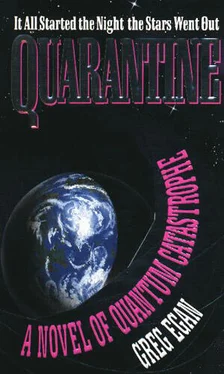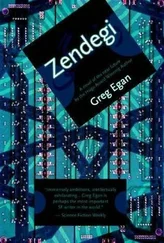No doubt any member of the Children, if told of Laura's date of conception, would ascribe a great significance to her abduction — but to treat that as proof of their involvement is ludicrous. The question is not: what does this signify to the Children? For the Children to have played a part in every single crime, worldwide, in which they would discern some cosmic portent, Duprey's following would need to have been underestimated by a factor of about a million.
Running away would be pathetic.
Still. I have nothing to lose but money. I could err on the side of caution, I could drop the case, regardless. Yeah, and I could join the ranks of people so cowed by the Children's atrocities that they hunt obsessively through the patterns of their lives in search of danger signs, and lock themselves in their homes on every anniversary of every petty stage of Duprey's lukewarm bloodless martyrdom, observing the holy days of their own religion of fear.
I unpack.
It's almost sunrise. Lack of sleep, as it often does, has left me with a peculiar feeling of clarity, a sense of having broken free of the mind's ordinary cycle, of having reached a profound new relationship with the world. I invoke Bossto force my endocrine system back into phase, and the delusion soon evaporates.
Compared to lightning-bolt revelations of terrorist involvement, the information I've assembled so far looks hopelessly ambiguous. But I have to start somewhere — and Biomedical Development International is the only company on the list without a blatantly innocent reason to be buying the cluster of drugs that Laura needs. And if BDI has no shareholders to impress, and hacking is too risky, I'm going to have to use more direct means to find out exactly what it is that they're researching.
I take a small box from my suitcase, and open it gently. Nestled in tissue paper, a mosquito is sleeping.
I lack the specialist mod used to program the insect, but a second compartment of the box contains a ROM, bearing old-style sequential software which will let me do the job, albeit more slowly. I lift out the chip, and switch it on. It glows invisibly in modulated infrared, and the bioengineered IR transceiver cells, scattered throughout the skin of my hands and face, collect and demodulate the signal. RedNet(NeuroComm, $1,499) receives the nerve impulses from these cells, and decodes and buffers the data.
I pass the program to von Neumann(Continental BioLogic, $3,150). Simulating a general-purpose computer isn't something a neural network does with great efficiency — hence the need for specialized mods, physically optimized for their tasks, instead of a single, programmable 'computer-in-the-skull'. But nobody can afford to buy every mod on the market — and you'd probably impair normal brain function if you commandeered that many neurons. So, quaint as it may be, sometimes loading a ROM full of sequential software is the only practical solution.
Culex explorator is purely organic, but heavily modified, both genetically and post-developmentally; most of the genetic tampering is simply to give the mature insect enough neurons for the nanomachines to rewire — plus its own IR transceivers, of course. I select the behavioural parameters I want from the menus in my head, wait five minutes while the program encodes them into the language of the mosquito's neural schemata, then cup my hand over the box for maximum signal strength and ram my decisions into the insect's tiny brain. There are endless layers of error checking in the RedNetprotocol, but I run a full read-back of the data anyway, which confirms success.
On my way to the underground, the streets are already far from empty. Food vendors stand by steaming barrows, and customers flock to them, ignoring the seductively photographed — but olfactorily barren — holographic temptations of dispensing machines. I buy a bag of noodles and eat as I walk. Sharply dressed executives, bankers and databrokers stride past me; people who could easily work from their homes, who could operate entirely within their own skulls — and even, with the help of mods, choose to enjoy it. It's hard to admit that the sight of these umbrella-wielding infocrats hurrying by, radiating self-importance, strikes me as some kind of affirmation of the human spirit. The light suddenly dims, and I look up to see two layers of churning grey cloud racing each other across the sky. Seconds later, I'm drenched.
The R&D heart of New Hong Kong lies twenty kilometres to the west of the city centre. I emerge from the underground into an almost deserted world of sprawling concrete buildings set in lawns so perfect that if they're real, they might as well not be. The sense of space here seems almost scandalous after the city's crowds and towers; many of the labs and factories are fifteen or twenty storeys high, but the streets are wide enough, the grounds sufficiently spacious, to keep the architecture from crowding out the sky — mercurially, already blue again from horizon to horizon.
I pause to shake Culex out of its box onto my palm; it clings to the skin. I hold it up to my eyes; I can just make out the tiny specks of the twelve data chameleons adhering to the sides of the thorax. I curl my fingers into a loose fist before setting off again. It takes a certain effort to adopt a casual gait with twenty thousand dollars' worth of counter-security equipment in the palm of your hand.
The maze-like region to the north of the underground bears all the hallmarks of having once consisted of a number of distinct, self-consciously constructed 'science parks', which have since overflowed into the space between. Each must have had its own orderly — if bizarre — avant-garde street plan, with its own peculiar symmetries and hierarchies, and each has had some degree of success in propagating the pattern beyond its original boundaries, but where two or more incompatible designs have come into conflict, the result can only be described as pathological. BDI itself lies at the end of a cul-de-sac — which precludes a nonchalant stroll past the front entrance — but the whole area is such a capillaceous mass of tiny streets on disconnected branches that I should be able to get close enough to the rear of the building while seeming to be headed somewhere else entirely.
The streets are quiet; I can even hear birdsong. One passing cyclist gives me a puzzled second glance; there seem to be no other pedestrians about, and I feel, prematurely, like a trespasser. These may be public streets, but they all lead to a small number of private destinations. In the unhkely event that someone stops to offer me directions, I'll just have to do my best lost-idiot-tourist act.
Finally, I catch sight of what I hope is BDI, an off-white concrete shoe box a hundred metres away, visible through the gap between Transgenic Ecocontrol and Industrial Morphogenesis. I can't actually see any identifying sign or logo from this angle, but I double-check against the street map in my head, and there's no doubt that I have the right building.
I catch myself thinking: an unlikely front for the Children of the Abyss… and I laugh aloud at this 'reassuring' observation. The Children are not involved — and I don't need to look for excuses to believe that. The biggest 'risk' I face from BDI is that they'll turn out to have nothing to do with the kidnapping at all.
I paste a copy of my visual field into the image buffer of the Culex program. I mark the building clearly, and then pulse this final message to the insect itself. I raise my hand and open my palm; the mosquito rises at once, circles above me a couple of times, and then vanishes.
I spend most of the day examining the information that's publicly available about BDI's owner, Wei Pai-ling. I dutifully plough through twenty-five years of news-system coverage — he averages about six articles a year — but I find nothing remarkable. The only report that's not strictly business news is the opening of a new wing of the NHKScienceMuseum; Wei led the consortium which raised the funds, and the article quotes from his platitudinous speech: Our children's future relies on stimulating their intellects and imaginations from the earliest age …'
Читать дальше










